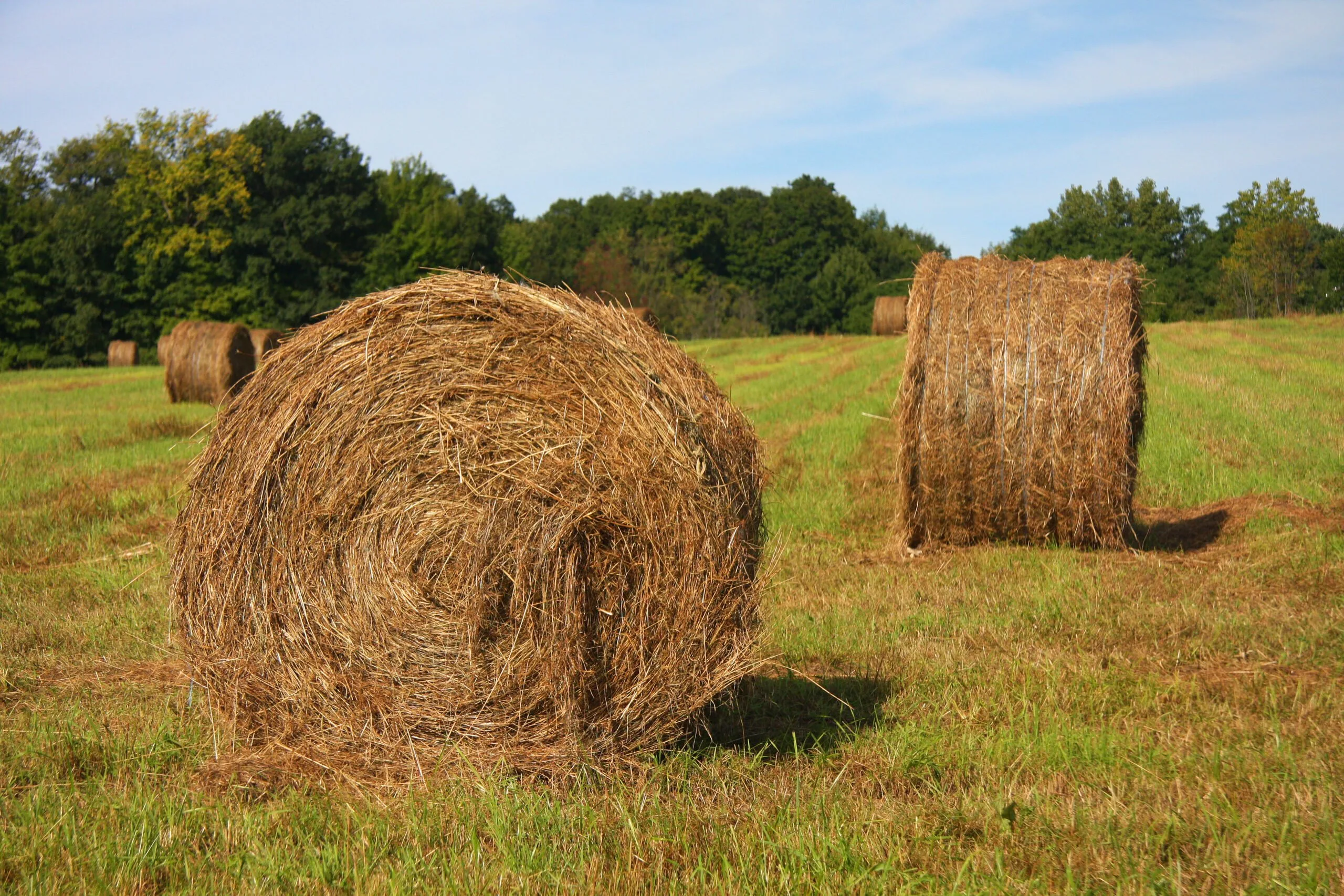Hay bales for horses and other livestock come in two shapes: square and round.
- There are about 25 square bales of hay in every round bale.
- Although weights vary due to the type of grass and moisture level, square bales weigh about 40 pounds and round bales weigh about 1000 pounds!
- The cost of horse hay varies a lot based on quality and availability. Typically, horse owners can save around 30%-50% on feeding costs by feeding hay via round bales, however, moving roundbales requires expensive specialized equipment and if not stored properly that savings can be lost to waste.
| Round Bales | Square Bales | |
|---|---|---|
| Dimensions | 4 ft deep x 5ft tall x 5ft wide | 14 in high x 18 in wide x 35 in long |
| Weight | 1000-1700 pounds | 40-75 pounds |
| Flakes | N/A | 10-12 |
| Waste (%) | Approximately 30% | Approximately 10% |

🌾 6 Tips for Handling Large Round Bales of Hay 🌾
- 🔧 Use proper equipment: Invest in equipment designed for handling round bales, such as bale spears, bale forks, or bale grabs. These attachments are specifically designed to secure and transport round bales safely. Because these bales weigh so much, they can be risky to move without the right equipment.
- 🛠️ Assess bale stability: Before attempting to move a round bale, check its stability. Ensure that the bale is tightly wrapped and not loose or sagging- loose bales are more likely to collapse during handling.
- 🚜 Use a reliable tractor: Make sure you have a tractor with enough horsepower and hydraulic capacity to handle the weight of the round bales. Using an underpowered lawn tractor can destabilize the tractor.
- ⚓ Secure the bales properly: Use the appropriate attachments to secure the bale firmly to the loader or spear. Ensure that the bale is centered and balanced to prevent it from tipping or shifting during transport.
- 🚦 Be cautious during transport: When moving round bales, drive slowly and avoid sudden turns or movements. Be aware of any obstacles or uneven terrain that may affect stability.
- 🏢 Store bales properly: After moving the round bales to the desired location, store them on a flat, well-drained surface away from moisture or standing water. Storing bales in a way that minimizes their exposure to the elements will help maintain their quality and nutritional value over time.
More on Round Bale Storage
Round bales of hay are often stored outside on the ground. This is the cheapest method for storage but can lead to the greatest waste due to weathering. When stored outdoors, moisture accumulates at the bottom of the bale where there is less air movement.
You can preserve round bales and keep your horsekeeping costs down by using poles, pallets, tires, crushed rock, or other materials to separate the bale from the wet soil below. According to the University of Kentucky, this can reduce these losses by up to 38%.1 Wrapping round bales with plastic sheets can reduce this loss to just 7%1 although indoor storage is more sustainable and less harmful to the environment. Round bales stored indoors lose about 15% of their mass to waste.2
Keep reading to learn more about managing hay in both round and square bale form. In this post, I share:
- 🟨🟡 5 key differences between square and round hay bales.
- 🚜 The main benefits of round hay bales.
- Advice from a pro on how to best handle large round bales of hay.
Square Bales Vs. Round Bales: 5 Key Differences
Hay is for horses, as the old adage goes! It’s important to know the basics of hay bales when learning how to care for horses.
- Shape: The most obvious difference is the shape of the bales. Square hay bales are, as the name suggests, square in shape. On the other hand, round hay bales are cylindrical or round in shape. They look like giant, solid rolls of hay when fresh.
- Over time, such as over the course of a winter, round bales get flat on the bottom and change shape. This is due to weight compressing the bottom layers.
- Size: Square bales are much smaller and more compact compared to round bales.
- Standard size for a square bale of Timothy, alfalfa, or mixed grass hay is 14 inches in height, 18 inches in width, and 36 inches in length.
- Round bales of hay can be quite large! They’re usually about 4 feet in diameter and 5 feet in height. Round hay bales weigh anywhere from 500 to 1200 lbs!
- Construction: Hay is made by drying grass and then compressing it. Square Bales and round bales are made by compressing the dry grass in different ways:
- Square bales are made by compacting hay into individual “flakes” and then tying multiple hay flakes together using special twine. The size of these flakes can vary, but they are typically uniform throughout the bale. Usually, horses are fed a certain number of “flakes” each day during daily horse chores, but some horses are fed hay by weight.
- Round bales, on the other hand, are created using specialized machinery that creates flattened layers of grass. The hay is rolled up into a cylinder shape and bound together using netting.
- For farmers with certain tractor attachments, it’s possible to unroll an entire bale! Unrolled, a round bale of hay is about 20-30 feet long. This method is used when feeding large herds, because it avoids crowding around the bale.
- Feeding: Square bales are often fed one or two flakes at a time, but round bales are typically placed in feeders for free feeding, which help animals access the hay without wasting or trampling on it. Both round and square bales are incompatible with feed bags.
- Cost and Availability: The prices of square and round bales can vary depending on factors such as location, type of hay, and market conditions. Generally, round bales tend to have a lower cost per pound of hay compared to square bales. This is due to the more efficient production and handling processes involved in making round bales.

What Are the Benefits of Round Hay Bales?
If both types of bales are made with the same hay and can be used to feed horses, why do so many horse owners choose to make round hay bales?
First of all, they’re cost-effective. That means they’re cheaper to make compared to square bales, which for any former is a bonus!
Secondly, round bales are easier to handle. They can be rolled or pushed around, so you don’t need to be super strong to move them.
Lastly, round bales take up less space. Their shape and density make them space-savers. You can stack them up nicely or store them outside (but make sure to protect them from the weather!). So, if you have limited storage space, round bales are a smart choice.
How Many Square Hay Bales Fit in a Round Hay Bale?
The answer depends on the size and density of both bale types. According to experiences shared by our community of horse owners, a round bale can usually hold anywhere from 10 to 25 square bales. That’s a pretty wide range, isn’t it?
The number of square bales that can fit in a round bale of hay can vary widely depending on several factors, including the size and density of the bales. However, according to our research from several horse forums, there are some commonly mentioned estimates:
- There are about 20-25 square bales worth of hay in every round bale, but you should go by weight whenever possible, since the type of hay, quality of hay vs weeds, and drying practices affect how much edible, nutritionally rich hay is contained within each large round bale.
Common Questions about Hay Bales:
How much does a bale of hay weigh?
Square bales of hay weigh between 40 and 60 pounds. Large round bales weigh over 1000 lbs (that’s half a ton!).
How many flakes in a bale of hay?
An average bale of grass hay has 10-12 flakes. A flake of hay usually weighs between 3-5 lbs.
How many square bales are in a round bale?
A round bale of hay is equivalent to about 20-25 small bales of hay. However, depending on how your round bales are stored, you should factor in as much as a 40% loss in edible mass due to spoilage.
How much does a bale of hay cost?
A small square bale of hay costs between $4 and $12, on average. The cost of a bale of hay varies by the type and quality of hay. Most hay sellers also adjust price to cover the cost of shipping the hay, so locally-produced hay is much less expensive than hay grown far away and trucked in. For this reason, hay is often much more expensive in urban areas, desert environments, and tropical regions.
In Review:
Square bales and round bales may both be made of hay, but they are different in shape, size, and handling. Whether you prefer the compactness of square bales or the efficiency of round bales, one thing is certain: they both play a vital role in feeding horses!
- Collins, M., Ditsch, D., Henning, J. C., Turner, L. W., Isaacs, S., & Lacefield, G. D. (1997). Round bale hay storage in Kentucky. University of Kentucky College of Agriculture, Lexington, and Kentucky State University, Frankfort. [↩] [↩]
- Belyea, R. L., Martz, F. A., & Bell, S. (1985). Storage and feeding losses of large round bales. Journal of Dairy Science, 68(12), 3371-3375. [↩]
